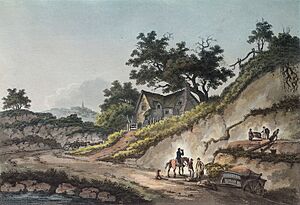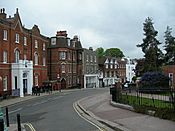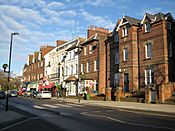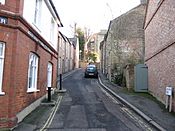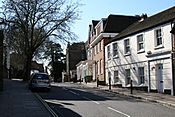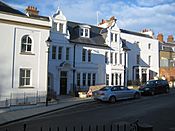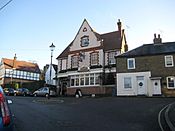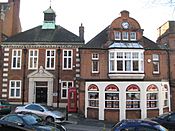Harrow on the Hill facts for kids
Quick facts for kids Harrow on the Hill |
|
|---|---|
 Harrow-on-the-Hill High Street (36-40 in picture), with the spire of St Mary's Church visible in the background At Centre: Listed Drinking Fountain |
|
| Population | 12,270 (2011 Census.Ward) |
| OS grid reference | TQ155865 |
| Ceremonial county | Greater London |
| Region | |
| Country | England |
| Sovereign state | United Kingdom |
| Post town | HARROW |
| Postcode district | HA1 |
| Dialling code | 020 |
| Police | Metropolitan |
| Fire | London |
| Ambulance | London |
| EU Parliament | London |
| UK Parliament |
|
Harrow on the Hill is a special and old village in the Harrow area of Greater London, England. It's named after Harrow Hill, which is about 124 metres (408 feet) high. The village is located about half a mile south of the main town of Harrow.
This historic village started way back in the medieval times. It grew up around the St Mary's Church, which was built in the 11th century. Today, it's also home to famous schools like Harrow, St Dominic's, and John Lyon schools.
Contents
What's in a Name?
The name "Harrow on the Hill" has a long history. Before 1398, it was simply known as "Harrow." The name "Harrow Hill" was first written down in 767 as Gumeninga Hergae.
One idea for what this old name means is "heathen temple" of a tribe called the 'Gumeningas'. These were people who lived there a very long time ago. Another early record of the name, from 1398, calls it Harrowe atte Hille. This means "Harrow at the Hill." Some people also think the name means "the church upon the hill."
A Look Back in Time
Harrow on the Hill used to be a very old parish (a local area) in Middlesex. In 1831, it had about 3,861 people and covered a large area of about 9,870 acres.
Over the years, the boundaries changed quite a bit. In 1894, parts of the parish were used to create new areas like Harrow Weald and Wembley. The small village of Greenhill to the north also grew into what is now the modern town of Harrow.
By 1931, the area of Harrow on the Hill was smaller, but its population had grown to 26,380 people. It became an "Urban District" in 1894. Later, in 1934, it joined with other areas to form a new larger district of Harrow. In 1965, it became part of Greater London and is now known as the London Borough of Harrow.
King Charles I's Visit
On April 27, 1646, King Charles I was trying to escape from Oxford. He stopped at Harrow on the Hill, close to St Mary's Church. He wanted to take one last look at London before he went to surrender to the Scottish Army. He also watered his horses there.
There's a special plaque on Grove Hill, near Harrow School, that marks this spot. It also says that a spring (a natural water source) below has been called King Charles' Well ever since that day.
Old Photographs
The Hills & Saunders photography company had a studio in Harrow on the Hill in the 1860s. They took many pictures of the schools, families, and the local area.
There are about 80,000 old glass plates from their work still in existence. Many of these amazing historical photos can be seen online on the Harrow Photos website.
Who Lives Here?
In 2011, the population of the Harrow on the Hill area was 12,270 people. It covers about 357 hectares. The hill itself is about 100 hectares.
The people living in Harrow on the Hill come from many different backgrounds. In 2011, about 47.3% were White, and 35.4% were Asian (mostly Indian and "Other Asian"). The most common languages spoken, after English, were Gujarati and Tamil. Many families in the Asian community in Harrow are quite well-off.
About half of the homes are houses or bungalows, and the other half are flats or maisonettes. Most people (57.6%) own their homes. Many residents (28.4%) have professional jobs. The unemployment rate for working people was low, at 4.1%. The average age of people living here was 33.5 years old.
Gallery
-
View of the north of the High Street
Taken from the junction of Church Hill
Some of the buildings are those of Harrow School -
Waldron Road
A very narrow two way road by London standards, also close to Harrow School -
Former public house and coaching inn
-
The former fire station (right) now an estate agent, and on the left the former headquarters of Harrow Urban District (now the London Borough of Harrow)
-
Partial Panorama looking northwest towards Pinner (left) and Headstone (right) from building at the bottom of the northern downslope of Harrow on the Hill (200m north of the mainline station) - the listed building on the left in the foreground is 315 Station Road, Harrow,
closest to the hill itself, currently occupied by NatWest
Places of Worship
Harrow on the Hill has an important church called St. Mary's, Harrow on the Hill. It was officially opened by St Anselm in 1094. There is also a Roman Catholic church at the bottom of the hill. It's called Our Lady and St Thomas of Canterbury, Harrow, and is dedicated to Our Lady and St Thomas of Canterbury.
The area also has four Catholic schools and three Church of England schools, showing its strong religious history.
Getting Around
The Harrow-on-the-Hill station is named after the village, but it's actually a bit north of the hill itself. You can catch the London Underground's Metropolitan line from here. The station also has trains from Chiltern Railways on the London to Aylesbury Line. These trains can take you into central London or out to the west and north-west.
Another station, South Harrow, is about the same distance from the top of the hill. This station is on the Piccadilly line. If you prefer buses, the 258 and H17 London bus routes go right over Harrow on the Hill.
First Car Accident Fatality
On February 25, 1969, a plaque was put up on Grove Hill. It tells a sad story about the first recorded car accident in Great Britain where the driver died. This happened right here in Harrow on the Hill, on Grove Hill, seventy years earlier, on February 25, 1899.
The plaque doesn't say the driver's name, but we know it was Edwin Sewell, a 31-year-old engineer. He was driving a 6-horsepower Daimler car. A back wheel broke, and the car crashed into a strong brick wall. Edwin Sewell died right away. His passenger, Major Richer, died three days later in the hospital.
Early Train Accident
In the graveyard of St Mary's church, there's a gravestone for Thomas Port. He died in a train accident on August 7, 1838. This shows that even early trains could be dangerous.
Nearby Areas
 |
West Harrow | Harrow | Kenton |  |
| South Harrow | Northwick Park | |||
| Greenford | Sudbury | Wembley |



